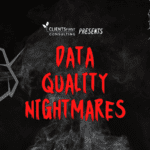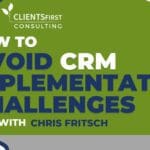Get a Grip on Your CRM Data: 7 Steps to Improve Data Quality

Good data quality may seem like a lofty goal, because keeping CRM contact records clean and current requires some frequent heavy lifting. These seven steps can bring better data quality within reach.
Data – Your Most Valuable Asset
Almost every marketer knows that good CRM data helps to drive and deliver results and provides the actionable insights necessary to enhance client service and ultimately develop business. But without accurate or complete data, being able to provide an outstanding client experience or to market your services effectively can be a long, hard climb. To effectively develop new clients and keep current Clients, it’s essential to continually improve the quality of your data.
The Data on Bad Data
Research estimates that without dedicated attention to data quality, up to 30% of an organization’s data can become outdated or incorrect each year. Just think about losing a third of the value of your most valuable asset!
While it may seem daunting, improving the quality of your CRM data doesn’t have to be complicated, costly or time consuming. In fact, if your plan addresses the following seven essentials for achieving CRM data quality, your ability to get the client service and business development results you want increases exponentially.
Essentials for CRM Data Quality
1. Set Goals
Do you know what you want to achieve? If not, how will you know when you get there. It’s imperative to set measurable, achievable goals agreed upon by key stakeholders. Some common goals might include:
-
- Identifying more qualified leads or prospects
- Developing a new service line for a niche market
- Having more frequent communication with Clients or referral sources
Once you have clearly identified your goals, you can determine which data you will need to gather that can deliver actionable insights and improve results.
2. Define the Processes
Firms that have implemented a CRM system have a good tool to help manage their data more effectively, but without processes in place, data quality can quickly deteriorate. Once you’ve outlined what you want to know and what data you need to collect, define a process to establish accountability for data collection, management and maintenance. It’s important that your team understands the quality expectations and desired results as well as their respective roles in assisting.
3. Don’t Forget Culture
Embedding CRM into your culture can be one of the greatest challenges you’ll face. Successful adoption of the system depends not just on participation by the marketing team but also on the backing from leaders and adoption through the ranks of users and their administrative staff. Everyone who will use the system needs training, but make sure every training session includes the impact and benefits of clean CRM data – not only for the organization, but for them personally.
4. Design for Simplicity
Develop your CRM solution to ensure the consistency and completeness of your data. Help your users input good data by including features such as pre-defined drop-down menus, triggers to prevent the creation of duplicate records and completeness and validity checks that can be applied to ensure nothing is missed. Make it simple and you will save time and effort while building a base of clean, correct and complete data.
5. Track Data Performance
CRM data is often used for email marketing, and your campaign results are only as good as the quality of the contact data in your CRM. By tracking returned or bounced emails from your email campaigns, you can quickly identify contact records that need updating, allowing you to monitor the quality of your data and improve upon it. As an added benefit, you can track key contacts who may have changed jobs or roles and share this information with your users, so that they can keep track of them or reach out to them in their new roles.
6. Use Data Quality Tools
To achieve your data quality goals, you need to be able to easily manage, maintain, clean and segment your data. If you have a large amount of contact data, as most firms do, there are various automated data quality tools and processes that can quickly, easily and inexpensively help you ensure that your CRM data is duplicate free and up-to-date. Using data quality tools will not only give you greater control of your data, but they can also help you extract key pieces of information you may need.
7. The Final Step – Get Good People
Good CRM data quality requires good people. It’s most important that all employees who input, access, manipulate and update CRM records understand data management. There is simply no substitute for dedicated, well-trained professionals to manage your most valuable asset. In fact, many organizations have a dedicated go-to data person or “data steward.” Ideally this individual is a skilled researcher who is intimately familiar with your CRM system, data and processes. They should run periodic checks of the system and data quality, identify issues, merge duplicates, enhance contact information, improve workflows and help get your data clean, correct and complete. If your organization doesn’t need or want to bring on a more staff members, outsourced data quality professional resources can be acquired easily and often less expensively than hiring an internal person.
Once you have completed all seven success steps, you will be on your way to better data.
Chris Fritsch is a Business Development Technology Success Consultant and the Founder of CLIENTSFirst Consulting. For more than 10 years, the CLIENTSFirst team of almost 100 consultants and experienced professionals has been helping law firms and other organizations successfully select and implement marketing and business development technology and improve Data Quality to maximize value, adoption and return on investment. If you need help achieving CRM Success, please contact us at 404-249-9914 or Info@CLIENTSFirstConsulting.com.







